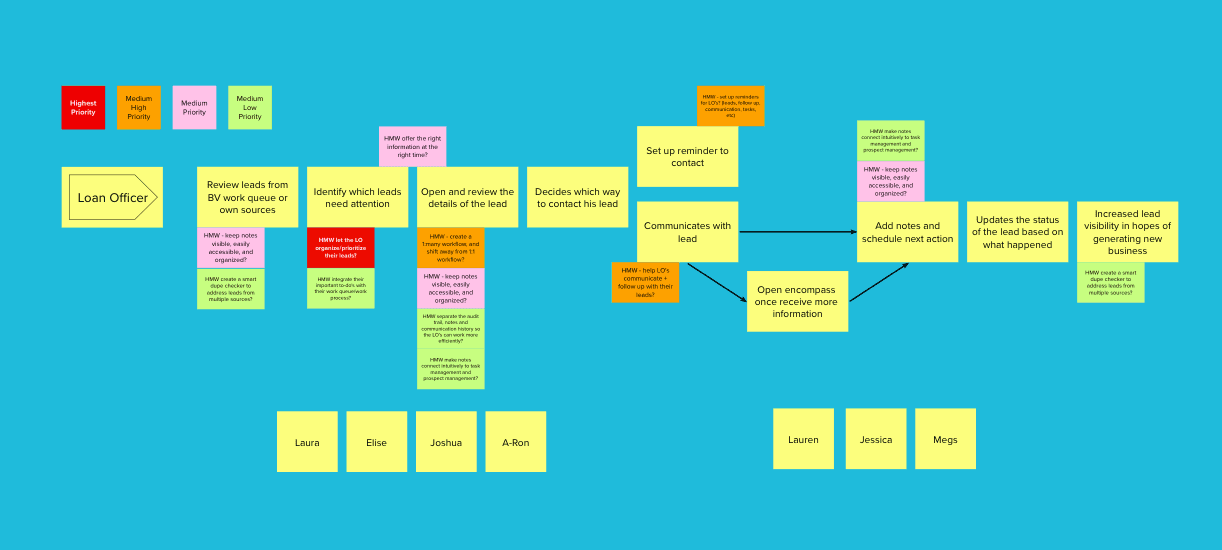lead management software
The Product
Cosmos - A greenfield loan officer CRM designed to replace NAF's outdated software (Bankerview). The proper successor of the interim CRM (Bridge).
The Team
Joshua Han (UX Researcher), Megs Work (Jr. UX Researcher), Elise Munoz (UX/UI Designer), Kristen Falk (UX/UI Designer), Laura Ramos (Sr. UX/UI Designer), Aaron L. (Product Manager), Lauren S. (Business Analyst), Jessica C. (Product Manager)
User Persona
Inside Loan Officer (ILA)
Outside Loan Officer (OLA)
Sprint Type
5 Day Sprint
the problem
The introduction of Cosmos heralded the intended replacement of two of NAF's existing CRMs: Bridge and Bankerview. While Bankerview boasted robust functionality, its outdated, clunky, and sluggish nature, coupled with a challenging navigation experience, prompted the need for a transformative approach.
Our team aimed to leverage Bankerview's existing lead management flow as a foundation and embark on a significant optimization effort. This initial initiative served as a crucial groundwork-laying phase for Cosmos and its subsequent features.
the sprint
Led by our UX researcher, the entire team embarked on a focused 5-day sprint to address the challenges highlighted by leadership. Below is a condensed summary of the week-long sprint:
Day 1: Mapping
Day 2: Sketching
Day 3: Deciding
Day 4: Prototyping
Day 5: Testing + Demo
Day 1: Mapping
Activities: Ask The Experts + HMW's, Organizing HMW's, Identifying Long-Term Goals, Sprint Questions, Note-N-Map, User Journey Mapping.
The top selected HMW's were:
How might we... let the loan officer organize/prioritize their leads?
How might we... create a one-to-many workflow, and shift away from one-to-one workflow?
How might we... set up reminders for loan officer leads, follow up, communications, tasks, etc.?
How might we... help loan officer's communicate and follow up with their leads?
Day 2: Sketching
Ideation activities: Lightning Demos, Brain Dumping, Idea Sketching, Crazy 8's, Solution Sketching.
Day 3: Decide
Decision-making activities: Art Museum (Solution Sketch Showcase), Speed Critique, Voting, Storyboarding.
Voting session determined prototype features; team members allocated votes for inclusion.
Advocacy for Kanban design: Recognizing the value for multitasking loan officers, Kanban design was added to the testing prototype.
Day 4: Prototype
Finally, it was time to get to work. The team split up responsibilities and roles in the following ways:
Makers: To design and the entire testable and interactive prototype (Elise and Me)
Stitcher: Due to the time crunch, this role was there to make sure all screens stayed consistent in design. Would also help with copy placement or other minor tasks if needed (Joshua Han)
Researchers: Draft interview script (Megan and Lauren)
Writer: To write all necessary copy required in the prototype (Jessica)
Asset Collector: To find all assets as requested for the prototype (Aaron)
Day 5: Test
UXR team conducted 6 usability tests (3 ILA and 3 OLA) via online calls, assessing tasks completion, user thoughts, and overall performance.
conclusion and forward planning
In our inaugural feature exploration for Cosmos, the testing phase yielded exceptional results, and the prototype demonstrated remarkable performance. The unanimous sentiment among loan officers was one of appreciation for the enhanced usability and added value embedded in the prototype. Particularly noteworthy was the positive reception of the Kanban board, eliciting exciting responses from users.
The team collectively deemed this a successful initiation for Cosmos, paving the way for the design team to proceed with elevating the testing prototypes to high-fidelity versions. Concurrently, it was decided to defer the integration of the Kanban board for future consideration.
In my capacity as the design lead for Cosmos, my responsibilities extended to crafting the brand guide and ensuring a steadfast commitment to quality and consistency throughout the product.
Several months later, post-initial prototype development and the incorporation of additional features, the final solutions took shape as follows:













